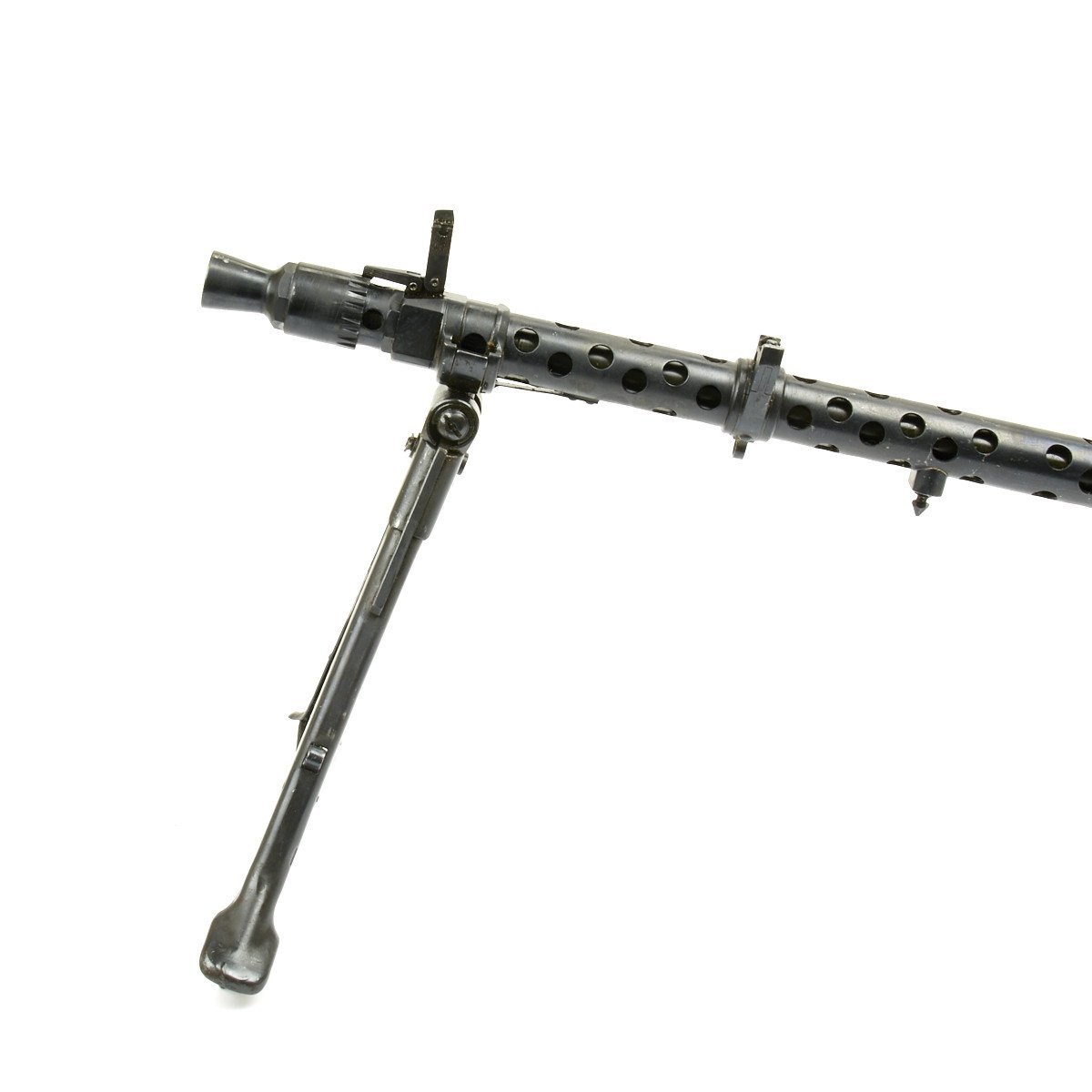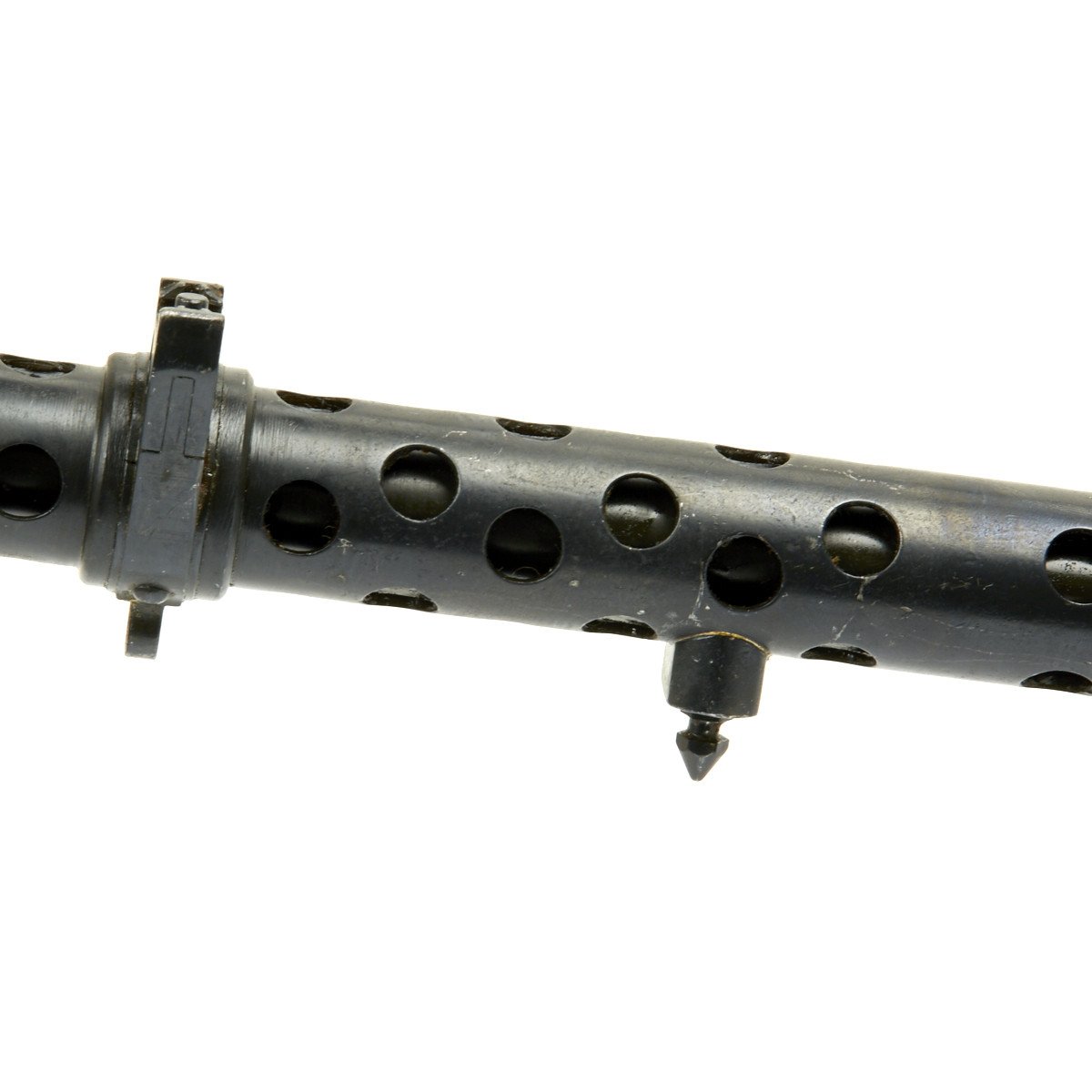German German WWII MG 34 Display Machine Gun with Bakelite Buttstock – marked dot 1944 Original Items
$ 3.095,00 $ 773,75
Original Item: Only One available! This is one of our original WWII issue MG34 display machine guns. It is coded along with multiple German wartime markings and has multiple waffen amt proofs throughout. It bears serial number 3362 on the barrel jacket, along with dot 1944 for the Brno factory in Czechoslovakia. The top cover bears serial number 0524 on this very fine example of the most prolific German issued Light Machine gun of WW2.
Comprised of nearly entirely original WWII parts, this weapon has been rebuilt on an original WW2 re-welded de-milled receiver without internal parts that has been replaced with solid steel bar-stock. The receiver bears multiple waffen proofs as well as other markings. The bakelite buttstock is in very good condition.
The bipod included is of the early design, with a central height adjustment knob. The top cover and feed tray are both marked cof for Carl Eickhorn, Solingen, a prolific manufacturer of edged weapons that exists to this day.
A fine display MG 34 LMGs and one the very last we have to offer just perfect for your collection.
Please note that there may be various post-war markings on this display gun, in addition to the German WW2 markings.
The Maschinengewehr 34, or MG 34, is a German recoil-operated air-cooled machine gun, first tested in 1929, introduced in 1934, and issued to units in 1936. It accepts the 7.92×57mm Mauser cartridge, and is generally considered the world’s first general-purpose machine gun.
The versatile MG 34 was arguably the most advanced machine gun in the world at the time of its deployment. Its combination of exceptional mobility being light enough to be carried by one man and high rate of fire (of up to 900 rounds per minute) was unmatched. It entered service in great numbers following AH’s repudiation of the Versailles Treaty in 1936, and was first combat tested by German troops aiding Franco’s Nationalists in the Spanish Civil War. Nonetheless, the design proved too complex for mass production, and was supplemented by the cheaper and simpler MG 42, though both remained in service and production until the end of the war.
History
The MG 34 was based on a 1930 Rheinmetall design, the MG 30. The Swiss and Austrian militaries had both licensed and produced the MG 30 from Rheinmetall shortly after patent. The MG 30 design was adapted and modified by Heinrich Vollmer of Mauser Industries. Vollmer modified the feed mechanism to accept either drum magazines or belt ammunition. He also increased the rate of fire. The MG 34’s double crescent trigger dictated either semiautomatic or fully automatic firing modes.
In the field, the weapon could operate in offensive or defensive applications. The offensive model, with a mobile soldier, used a drum magazine that could hold either 50 or 75 rounds of ammunition. In a stationary defensive role, the gun was mounted on a bipod or tripod and fed by an ammunition belt. Belts were carried in boxes of five. Each belt contained 50 rounds. Belt lengths could be linked for sustained fire. During sustained fire, barrels would have to be changed at intervals due to the heat generated by the rapid rate of fire. If the barrels were not changed properly, the weapon would misfire. Changing barrels was a rapid process for the trained operator and involved disengaging a latch and swinging the receiver to the right for the insertion of a new barrel. Accordingly, stationary defensive positions required more than one operator.
The MG 34 was the mainstay of German Army support weapons[4] from the time of its first issue in 1935 until 1942, when it was supplanted by the next generation Maschinengewehr 42 or MG 42. Although the 34 was very reliable and dominant on the battlefield, its dissemination throughout the German forces was hampered due to its precision engineering, which resulted in high production costs and a relatively slower rate of production. For its successor, the MG 42, the Germans instead used mass production techniques similar to those that created the MP 40 submachine gun. However, the Germans nevertheless continued widespread production of MG 34s until the end of the war.
The MG 34 was used as the primary infantry machine gun during the 1930s, and remained as the primary armored vehicle defensive weapon. It was to be replaced in infantry service by the related MG 42, but there were never enough quantities of the new design to go around, and MG 34s soldiered on in all roles until the end of World War II. The MG 34 was intended to replace the MG 13 and other older machine guns, but these were still being used in World War II as demand was never met.
It was designed primarily by Heinrich Vollmer from the Mauser Werke, based on the recently introduced Rheinmetall-designed Solothurn 1930 (MG 30) that was starting to enter service in Switzerland. Changes to the operating mechanism improved the rate of fire to between 800 and 900 rpm.
The new gun was accepted for service almost immediately and was generally liked by the troops, and it was used to great effect by German soldiers assisting Nationalist Spain in the Spanish Civil War. At the time it was introduced, it had a number of advanced features and the general-purpose machine gun concept that it aspired to was an influential one. However, the MG 34 was also expensive, both in terms of construction and the raw materials needed (49 kg (108.0 lb) of steel),[citation needed] and its manufacture was too time-consuming to be built in the numbers required for the ever-expanding German armed forces. It was the standard machine gun of the Kriegsmarine (German navy).
Prompt Shipping and Professional Packaging
We provide a variety of shipping options due to our long-running partnerships with UPS, FedEx and DHL. Our warehouse personnel are well trained and will pack the goods according to our exact and precise specifications. Before shipping your items will be thoroughly inspected and secured. Every day, we deliver to thousands of customers in different countries. This is a sign of our determination to become the largest online retailer worldwide. Both Europe as well as the USA have warehouses and distribution centers.
Note that orders containing more than one item will be subject to a processing period that is based to the particular item.
Prior to shipping the items, our staff will carry out an exhaustive inspection of the products you ordered. Today, most orders will be delivered within 48 hours. The estimated delivery time is between 3-7 days.
Returns
The stock is constantly changing. It's not entirely managed by us since we are involved with multiple entities, including the factory and our storage. Therefore, the actual inventory could alter at any time. It is possible that you will not receive your order after the order has been made.
The period of time is 30 days. Unfortunately, if 30 days have passed since you purchased your product, we are unable to provide a refund or exchange.
The item must not be in use and must be in the original packaging. The item must be in the original packaging.
Related products
Uncategorized
Armored Burgonet Helmet & Polearm from Scottish Castle Leith Hall Circa 1700 Original Items
Uncategorized
Band of Brothers ORIGINAL GERMAN WWII Le. F.H. 18 10.5cm ARTILLERY PIECE Original Items
Uncategorized
Uncategorized
Uncategorized
Armoured Fighting Vehicles of the World: AFVs of World War One (Hardcover Book) New Made Items
Uncategorized
Angolan Rebel 1970s era 60mm Inert Display Mortar from Angolan Civil War Original Items
Uncategorized
Uncategorized
Uncategorized
Uncategorized
Uncategorized
Uncategorized
Uncategorized
Uncategorized
Uncategorized
Uncategorized
Uncategorized












































































